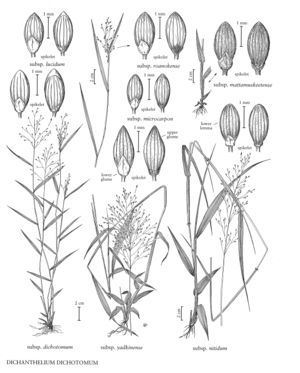Difference between revisions of "Dichanthelium dichotomum subsp. roanokense"
FNA>Volume Importer |
imported>Volume Importer |
||
| (8 intermediate revisions by 2 users not shown) | |||
| Line 6: | Line 6: | ||
|synonyms={{Treatment/ID/Synonym | |synonyms={{Treatment/ID/Synonym | ||
|name=Panicum roanokense | |name=Panicum roanokense | ||
| − | |authority= | + | |authority= |
| − | }}{{Treatment/ID/Synonym | + | |rank=species |
| + | }} {{Treatment/ID/Synonym | ||
|name=Panicum hirstii | |name=Panicum hirstii | ||
| − | |authority= | + | |authority= |
| − | }}{{Treatment/ID/Synonym | + | |rank=species |
| + | }} {{Treatment/ID/Synonym | ||
|name=Panicum dichotomum var. roanokense | |name=Panicum dichotomum var. roanokense | ||
| − | |authority= | + | |authority= |
| + | |rank=variety | ||
}} | }} | ||
|hierarchy=Poaceae;Poaceae subfam. Panicoideae;Poaceae tribe Paniceae;Dichanthelium;Dichanthelium sect. Dichanthelium;Dichanthelium dichotomum;Dichanthelium dichotomum subsp. roanokense | |hierarchy=Poaceae;Poaceae subfam. Panicoideae;Poaceae tribe Paniceae;Dichanthelium;Dichanthelium sect. Dichanthelium;Dichanthelium dichotomum;Dichanthelium dichotomum subsp. roanokense | ||
| Line 24: | Line 27: | ||
-->{{Treatment/Body | -->{{Treatment/Body | ||
| − | |discussion=<p>Dichanthelium dichotomum subsp. roanokense grows in marshes, wet pinelands, wet woods, and the borders of swamps. A relatively uncommon subspecies, it grows on the coastal plain from Delaware to south¬eastern Texas and in the West Indies.</p><!-- | + | |discussion=<p><i>Dichanthelium dichotomum </i>subsp.<i> roanokense</i> grows in marshes, wet pinelands, wet woods, and the borders of swamps. A relatively uncommon subspecies, it grows on the coastal plain from Delaware to south¬eastern Texas and in the West Indies.</p><!-- |
| − | --><p>It is very similar to subsp. dichotomum and also exhibits traits of Dichanthelium sphaerocarpon and D. erectifolium.</p> | + | --><p>It is very similar to <i></i>subsp.<i> dichotomum</i> and also exhibits traits of <i>Dichanthelium sphaerocarpon</i> and <i>D. erectifolium</i>.</p> |
|tables= | |tables= | ||
|references= | |references= | ||
| Line 34: | Line 37: | ||
-->{{#Taxon: | -->{{#Taxon: | ||
name=Dichanthelium dichotomum subsp. roanokense | name=Dichanthelium dichotomum subsp. roanokense | ||
| − | |||
|authority=(Ashe) Freckmann & Lelong | |authority=(Ashe) Freckmann & Lelong | ||
|rank=subspecies | |rank=subspecies | ||
| Line 41: | Line 43: | ||
|basionyms= | |basionyms= | ||
|family=Poaceae | |family=Poaceae | ||
| + | |illustrator=Linda A. Vorobik;Hana Pazdírková | ||
| + | |illustration copyright=Utah State University | ||
|reference=None | |reference=None | ||
|publication title= | |publication title= | ||
|publication year= | |publication year= | ||
|special status= | |special status= | ||
| − | |source xml=https:// | + | |source xml=https://bitbucket.org/aafc-mbb/fna-data-curation/src/200273ad09963decb8fc72550212de541d86569d/coarse_grained_fna_xml/V25/V25_1181.xml |
|subfamily=Poaceae subfam. Panicoideae | |subfamily=Poaceae subfam. Panicoideae | ||
|tribe=Poaceae tribe Paniceae | |tribe=Poaceae tribe Paniceae | ||
Latest revision as of 17:55, 11 May 2021
Culms to 100 cm, erect; nodes usually glabrous; internodes terete, usually glabrous, often slightly glaucous, sometimes olivaceous; fall phase with erect or decumbent culms, branching at the mid- and upper culm nodes, with numerous axillary branches, branches elongated and widely divergent, not forming fascicles. Cauline sheaths glabrous or the lowest sheaths sparsely pubescent; blades usually 5-8 mm wide, stiffly ascending or erect, often olivaceous or purplish abaxially, glabrous or sparsely pubescent basally. Spikelets 1.5-1.8 mm (seldom longer), broadly ellipsoid or obovoid, often purplish at the base, glabrous, obtuse to subacute. Upper florets 1.4-1.6 mm, broadly ellipsoid. 2n = unknown.
Discussion
Dichanthelium dichotomum subsp. roanokense grows in marshes, wet pinelands, wet woods, and the borders of swamps. A relatively uncommon subspecies, it grows on the coastal plain from Delaware to south¬eastern Texas and in the West Indies.
It is very similar to subsp. dichotomum and also exhibits traits of Dichanthelium sphaerocarpon and D. erectifolium.
Selected References
None.
